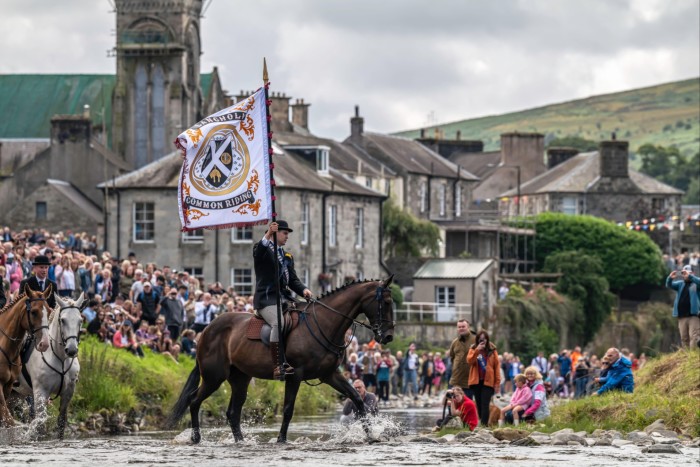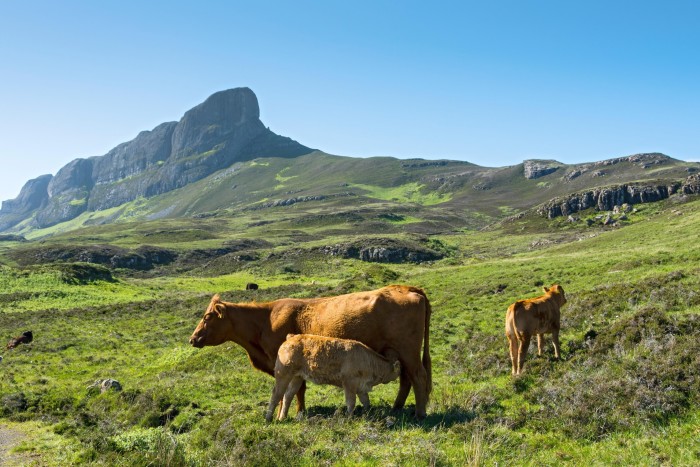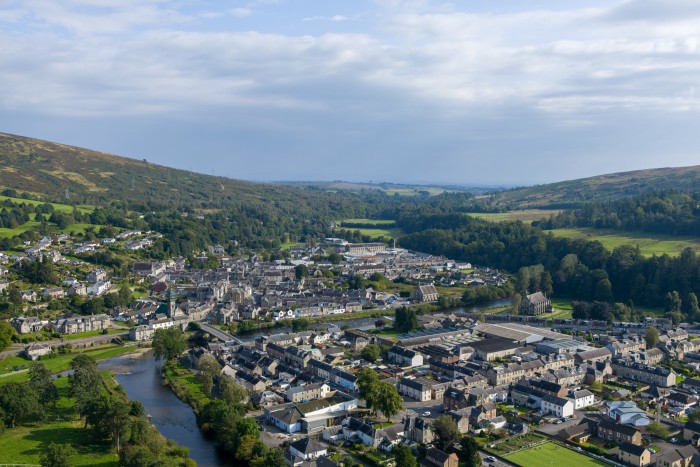
It’s not every day that you find thousands of people thronging the streets of the tiny Scottish town of Langholm; still less likely that you’ll find many of them dressed in suits, clutching pints of ale before breakfast. But this was no ordinary day. This was the day of the Common Riding, Langholm’s ancient celebration of its land rights.
Suddenly, the crowd fell silent. A man climbed on to the back of a horse, standing bolt upright on the saddle: the Crier of the Fair. He loudly began to recite a proclamation of the town’s centuries-old rights over nearby land: “Now, Gentlemen, we’re going from the Town, / And first of all the Kilngreen we go around, / It is an ancient place where clay is got, / And it belongs to us by Right and Lot.”
The people of Langholm, the crier explained, held common rights to gather stone for building and bracken for livestock bedding from land neighbouring the town.
The tradition is centuries old, but for the people of Langholm, communal land rights aren’t just a hangover from the past — they are now the proud owners of a vast moorland estate.
Today, there are some 700 assets in community ownership across Scotland, covering more than half a million acres of land. The transformation started in the 1990s with the community buyout of the Isle of Eigg. Local residents, dissatisfied with an absentee landlord, formed a trust and — in the words of land reform campaigner Alastair McIntosh — sought to “break the spell of consent that landlordism had enjoyed”, creating “a new constellation of possibility”.
Inspired by such events, the then Labour-led Scottish government passed the Land Reform (Scotland) Act 2003. Among other provisions, it created a Community Right to Buy, granting local groups powers to register an interest in rural land and right of first refusal when it comes up for sale.

In England, where such changes have yet to be implemented, 1 per cent of the population still owns half the land, much of it belonging to aristocratic families who can trace their lineage and possessions back to the Norman Conquest. A small number of large landowners are disproportionately responsible for the degradation of many British ecosystems.
It took just 13 venture capitalists to initiate the draining of the Fens, for example — what was once one of the largest wetlands in western Europe. Britain’s grey squirrels, which have decimated the native red variety, owe their prevalence to the 11th Duke of Bedford. And it was Queen Victoria and Prince Albert who popularised driven grouse shooting — leading to the transformation of our upland peat bogs and the release of vast quantities of carbon.
But the new Labour government has announced plans to introduce a Community Right to Buy via its English Devolution Bill. This, I’d argue, is a way of managing land that’s much more democratically accountable than simply trusting private landowners to be its custodians.
I’d initially come to Langholm to meet fellow Right to Roam campaigner Nadia Shaikh, in order to plan an event along the Scottish-English border. Hearing about the Common Riding, we’d decided to stay for the festivities. I stood watching the proceedings in fascination, sipping beer from a plastic pint glass.
The Common Riding was at once a story of resistance — the townspeople against the landowning Duke — and of unity: the town coming together to celebrate, and, of course, to get drunk.

It originates in 1759, when the town won the rights of common over the Kilngreen and Common Moss in a legal case involving the landowner, the Duke of Buccleuch — then, as now, one of the largest private landowners in Scotland. As a condition, each year the people of Langholm would have to mark the boundaries of the lands to which they applied.
For some time, however, there remained uncertainty over who owned the freehold. In 2019, all that changed, when the Duke put his Langholm Estate up for sale.
“Everything you can see, from here to the horizon,” says Jenny Barlow, estate manager for the Tarras Valley Nature Reserve, “is now owned by the community.”
From our vantage point, we drank in the view. Over 10,000 acres of purple heather, peat bog, ancient wood pasture and windswept hills, bisected by the River Tarras: this land used to be the Duke of Buccleuch’s grouse moor. Between 2020 and 2022 it was bought by the Langholm community and has become the Tarras Valley Nature Reserve.
I’d visited plenty of community-owned pubs and village halls but nothing on this scale. Barlow agreed. “It’s bloody massive!”
Shooting has ceased, as have the intensive management practices — such as moorland burning — previously deployed to maximise numbers of grouse. The plan is to keep it evolving as a “dynamic habitat”. There has been no grazing for some years, save for a few wild goats and roe deer. But Barlow intends to reintroduce a small number of animals so the hillside doesn’t simply become closed-canopy woodland, but rather a rich mosaic of scrub, woods and open habitats. “Once the hydrology has been restored through rewetting the peat, let’s see what the land wants to do,” she says.
Barlow used to work for the Environment Agency in Leeds to reduce flooding through natural means such as restoring peat and planting trees. She had to negotiate with private landowners, but felt “limited by land not belonging to the public . . . Imagine the number of communities in England who could benefit from buying their own natural flood defences.” In Scotland, where communities have greater powers to acquire land, she didn’t have to imagine.
So how did the community of Langholm come to possess its treasures? When the Duke of Buccleuch dropped the news that the moor was up for sale, Kevin Cumming, of local community development trust the Langholm Initiative, was trying to relax in his caravan on holiday. “From then on my phone never stopped ringing,” he says.

At the time, Cumming was working on a project to bring more income into Langholm through eco-tourism and saw that the land could be a huge shot in the arm. He wrote a proposal for a community buyout and transformation into a nature reserve. It was a bold plan. As one fundraising pamphlet put it: “It would be the biggest community buyout ever seen in Scotland south of the Great Glen, and the most extensive ecological restoration project outside of the Cairngorms.”
Volunteers went door-to-door and ended up with 800 signatures of support — around a third of Langholm’s population. This helped unlock a grant from the Scottish Land Fund, which enabled a business proposal to be written. Then it was a matter of raising the money: the 10,500-acre estate had been valued at £6.4mn. The Duke recognised this was a tall order for the community to raise in one go, and divided the land into two halves, holding one back from sale. This still meant raising more than £3mn. But some 4,000 people donated to the public fundraiser, and the community was able to draw on a £1mn grant from the Scottish Land Fund. A year later, they did it all over again to buy the second half.
Although development is in the early stages, income is being drawn from forestry, property rental and eco-tourism. But Barlow is keen to emphasise that community ownership, in her words, “isn’t a utopia . . . it can be messy, there are disagreements. If someone says, ‘everyone agrees with us’, you probably haven’t done your engagement right.”
One disagreement is over the future of sheep farming. There are still 1,300 sheep on the northern half of the moor, which might sit uneasily within a rewilding initiative. But community ownership could offer a way of resolving such differences through dialogue.
It’s a lesson those of us living in England can learn, if the new Labour government does give the public new powers to pursue community buyouts. We face a nature crisis — and those few who have owned the land for so long haven’t always done a great job of stewarding it. Isn’t it time to give the rest of us a go?
“The Lie of the Land: Who Really Cares for the Countryside?” by Guy Shrubsole (William Collins)
Find out about our latest stories first — follow @ft_houseandhome on Instagram